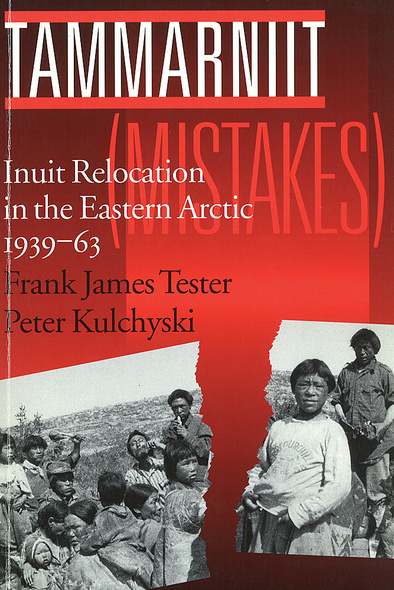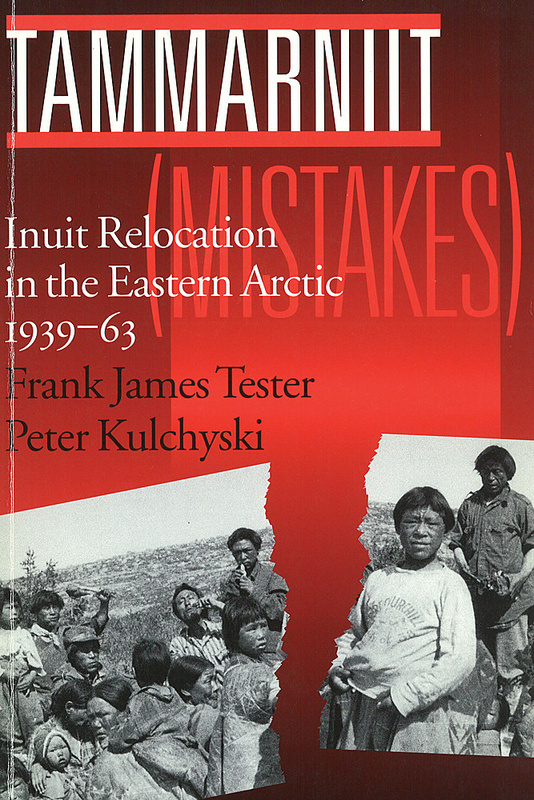Our shopping cart is currently down. To place an order, please contact our distributor, UTP Distribution, directly at utpbooks@utpress.utoronto.ca.
Tammarniit (Mistakes)
Inuit Relocation in the Eastern Arctic, 1939-63
Recent media attention on the dire living conditions of the Innu in Davis Inlet, Labrador, has served as a stark reminder of the tragic outcome of Canadian government policy toward the Inuit in the eastern Arctic between 1939 and 1963. In Tammarniit, Frank Tester and Peter Kulchyski focus on the roles of relief and relocation in response to welfare and other perceived problems and the federal government's overall goal of assimilating the Inuit into the dominant Canadian culture. As a result, the seeming benevolence of the post-Second World War Canadian welfare state is seriously questioned.
The authors have made extensive use of archival documents, many of which have not been available to researchers before, among them the Alex Stevenson Collection, which was stored in the Archives of the Northwest Territories and which proved to be invaluable in determining the course of events and the evolution of northern policies.
Tammarniit begins with an account of the debate over which branch of government should be responsible for the Inuit and whose budget should cover the costs for providing relief. This debate was resolved in 1939 when the Supreme Court of Canada ruled that the federal government was responsible. The following chapters cover the first wave of government expansion in the north, which coincided with the evolution of the postwar liberal welfare state; the policy debate that resulted in the decision to relocate Inuit from relatively southern communities on the east coast of Hudson Bay to the high Arctic; and the actual movement of people and materials.
The second half of the book focuses on conditions following relocation. A great deal of attention is paid to the Henik Lake and Garry Lake famines, both of which occurred in the Keewatin district in the late 1950s, and to the subsequent establishment of the community of Whale Cove. The book concludes with an examination of the second wave of state expansion in the late fifties and the emergence of a new dynamic of intervention.
Awards
- 1997, Winner - Outstanding Book, Gustavus Myers Center for the Study of Human Rights in North America
Treads the fine line of compassionate analysis and understanding. The authors avoid righteous condemnation, examing instead the complex ways in which decent, well-meaning officials fashioned a legacy of suffering from their own insensitivity, ignorance, and self-deception ... Like it or not, Canada is about to be transformed by the emerging powers of its aboriginal nations ... How Canada responds to these challenges will define the future shape of Confederation itself. In that sense, this book is both timely and significant.
In this important book, Tester and Kulchyski skillfully weave the episodes of Inuit relocations into the fabric of general postdepression Canadian history. The authors do an excellent job of revealing the complex relations between the government, the missionaries, the fur companies, and the Inuit. It is another excellent case study of the detrimental effects of governmental paternalism.
Tammarniit (Mistakes) makes an important contribution to our understandings of the recent history of the relationships between the Inuit of the eastern arctic and the Canadian state (in its various and complex manifestations).
Preface
Introduction
1 Are Inuit Indians?: Relief, Jurisdiction, and Government Responsibility
2 Social Welfare and Social Crisis in the Eastern Arctic
3 Planning for Relocation in the Eastern Arctic
4 Recolonizing the Arctic Islands: The 1953 Relocations to Resolute Bay and Craig Harbour
5 The Ennadai Lake Relocations, 1950-60
6 The Garry Lake Famine
7 The Whale Cove Relocation
8 Relocation and Responsibility, 1955-63
Notes
Bibliography
Index






